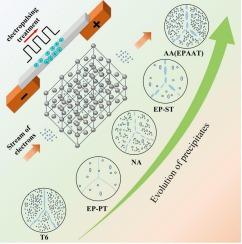Enhancing mechanical and corrosion properties of Al-Zn-Mg-Cu alloy through electropulsing and aging alternate treatment
IF 4.8
2区 材料科学
Q1 MATERIALS SCIENCE, CHARACTERIZATION & TESTING
引用次数: 0
Abstract
The contradiction between mechanical and corrosion properties restricts the further research and application of Al-Zn-Mg-Cu alloy. Studies report a new technique, electropulsing and aging alternate treatment (EPAAT), including twice electropulsing and aging treatment, to solve this contradiction by precisely controlling the intragranular precipitates and grain boundary precipitates (GBPs). The results show that the grain boundary precipitates (GBPs, η) are discontinuous and the intragranular precipitates (η’) are not coarsened after EPAAT. The precise regulation of precipitated phase by EPAAT can be attributed the differing effect of electropulsing current on the GBPs and the intragranular precipitates. Utilize electropulsing primary treatment to obtain the supersaturated solid solution. Following natural aging, the small continuous phases at the grain boundary and the GP zones within the grain were precipitated again. The small continuous GPBs of the sample diffuse along the grain boundaries and become discontinuously distributed, while the GP zones within the grain dissolve with under the electropulsing secondary treatment. After artificial aging, the intragranular phase is fully precipitated, yet the GBPs remain unchanged, thereby achieving phase regulation. Consequently, the icorr of Al-Zn-Mg-Cu alloy decreases from 28 to 5.87 μA/cm2 and the tensile strength increases from 511 MPa to 524 MPa. The EPAAT technology realizes the accurate treatment of Al-Zn-Mg-Cu alloys and provides a new solution for improving strength and corrosion properties.

通过电脉冲和时效交替处理提高铝锌镁铜合金的机械性能和腐蚀性能
机械性能和腐蚀性能之间的矛盾制约着铝锌镁铜合金的进一步研究和应用。研究报道了一种新技术--电脉冲和时效交替处理(EPAAT),包括两次电脉冲和时效处理,通过精确控制晶内析出物和晶界析出物(GBPs)来解决这一矛盾。结果表明,经过 EPAAT 处理后,晶界析出物(GBPs,η)是不连续的,而晶内析出物(η')没有粗化。EPAAT 对沉淀相的精确调节可归因于电脉冲电流对 GBP 和粒内沉淀物的不同影响。利用电脉冲初级处理获得过饱和固溶体。自然老化后,晶界上的小连续相和晶粒内的 GP 区再次析出。样品中的小型连续 GPB 沿晶界扩散,成为不连续分布,而晶粒内的 GP 区则在电脉冲二次处理下溶解。人工老化后,晶内相完全析出,但 GBP 仍保持不变,从而实现了相调节。因此,Al-Zn-Mg-Cu 合金的 icorr 从 28 μA/cm2 降至 5.87 μA/cm2,抗拉强度从 511 兆帕增至 524 兆帕。EPAAT 技术实现了铝锌镁铜合金的精确处理,为提高强度和腐蚀性能提供了新的解决方案。
本文章由计算机程序翻译,如有差异,请以英文原文为准。
求助全文
约1分钟内获得全文
求助全文
来源期刊

Materials Characterization
工程技术-材料科学:表征与测试
CiteScore
7.60
自引率
8.50%
发文量
746
审稿时长
36 days
期刊介绍:
Materials Characterization features original articles and state-of-the-art reviews on theoretical and practical aspects of the structure and behaviour of materials.
The Journal focuses on all characterization techniques, including all forms of microscopy (light, electron, acoustic, etc.,) and analysis (especially microanalysis and surface analytical techniques). Developments in both this wide range of techniques and their application to the quantification of the microstructure of materials are essential facets of the Journal.
The Journal provides the Materials Scientist/Engineer with up-to-date information on many types of materials with an underlying theme of explaining the behavior of materials using novel approaches. Materials covered by the journal include:
Metals & Alloys
Ceramics
Nanomaterials
Biomedical materials
Optical materials
Composites
Natural Materials.
 求助内容:
求助内容: 应助结果提醒方式:
应助结果提醒方式:


